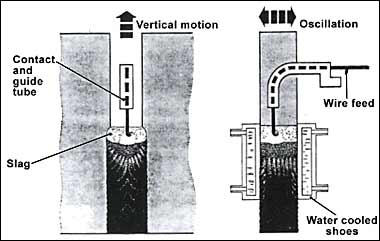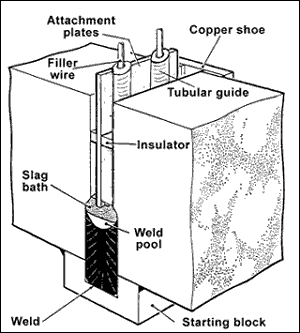Electro slag welding
by Owen Gorton
Description
Electro slag welding is a very efficient, single pass process carried
out in the vertical or near vertical position and used for joining steel
plates/sections in thicknesses of 25mm and above. It was developed by
the Paton Institute in the Ukraine in the early 1950s and superseded the
very high current submerged arc process for making longitudinal welds in
thick-walled pressure vessels.
Unlike other high current fusion processes, electro slag welding is
not an arc process. Heat required for melting both the
welding wire and the plate edges is generated through a molten slag's
resistance to the passage of an electric current.
In its original form, plates are held vertically approximately 30mm
apart with the edges of the plate cut normal to the surface. A bridging
run-on piece of the same thickness is attached to the bottom of the
plates. Water cooled copper shoes are then placed each side of the
joint, forming a rectangular cavity open at the top. Filler wire, which
is also the current carrier, is then fed into this cavity, initially
striking an arc through a small amount of flux. Additional flux is added
which melts forming a flux bath which rises and extinguishes the arc.
The added wire then melts into this bath sinking to the bottom before
solidifying to form the weld. For thick sections, additional wires may
be added and an even distribution of weld metal is achieved by
oscillating the wires across the joint. As welding progresses, both the
wire feed mechanism and the copper shoes are moved progressively upwards
until the top of the weld is reached. See figure 1.
 |
Fig.1. Electro slag welding
|
The consumable guide variant of the process uses a much simpler
set-up and equipment arrangement which does not require the wire feed
mechanism to climb. In this case, the wire is delivered to the weld pool
down a consumable, thick-walled tube which extends from the top of the
joint to the weldpool. Support for the molten bath is provided by two
pairs of copper shoes which are moved upwards, leapfrogging each other
as welding progresses. The tubular guides can be further supplemented by
additional consumable plates attached to the tube. Generally, as the
thickness of plate increases, the number of wires/guides increases,
approximately in the ratio of one wire per 50mm of thickness, see figure
2.
 |
Fig.2. Consumable guide welding
|
Current status
In the fabrication industry, the process continues to be used for thick
walled pressure vessels which are post-weld normalised and for
structures such as blast furnace shells and steel ladles which are used
at above ambient temperatures. The process is also extensively used for
the welding of railway points.
Important current issues
Considerable interest was shown in electro slag welding during the 1970s
when ideas for increasing welding speed were investigated. This was seen
as an important parameter for increasing productivity and as a way of
reducing heat input to improve HAZ and weld metal impact properties.
However, since that time little has been done by way of development.
Those developments that have taken place have been limited to the tuning
of parameters and tailoring techniques for specific applications.
Benefits
The principal benefits of the process are:
- speed of joint completion; typically 1 hour per metre of seam,
irrespective of thickness
- lack of angular distortion
- lateral angular distortion limited to 3mm per meter of weld
- high quality welds produced
- simple joint preparation, i.e. flame-cut square edge
- major repairs can be made simply by cutting out total weld and
re-welding
Risks
Electro slag welding is not one of the major welding processes because
the high heat input generates large, coarse grained weld metal and HAZs
which lead to poor fracture toughness properties in these areas.
Toughness improvements can only be achieved by post-weld normalising
treatment. Additionally, the near parallel-sided geometry of the weld,
combined with the coarse grains, can make it difficult to identify
defects at the fusion boundary by standard ultrasonic NDT techniques.
The process has considerable potential for increasing productivity.
However, its use has been limited because of relatively poor
understanding of the process and, for specific applications, the
significance of the fracture toughness values. As a result, use of the
process has been restricted to a few niche applications.
|

